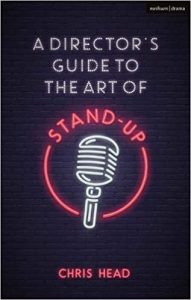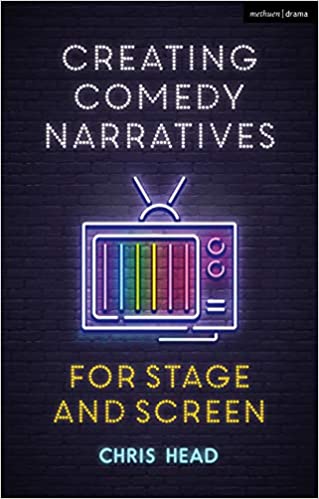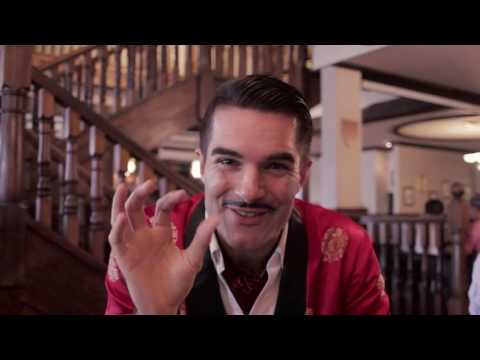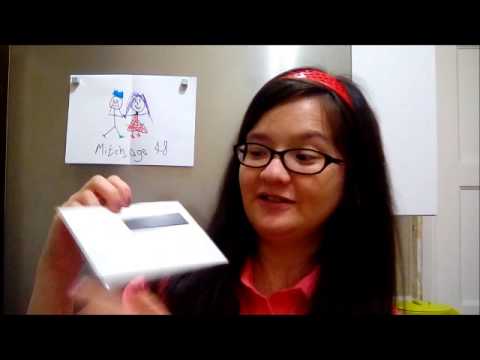Creating, Writing & Making Online Comedy Sketches & Shorts
By Chris Head and Steve Whiteley
I’m Chris Head, and in this blog Steve Whiteley and I will be discussing online comedy sketches and shorts. I’m a comedy director, coach, script-editor and author of “A Director’s Guide to the Art of Stand-up”. Steve (pictured above on “Swiped” shoot) is an actor, film maker and the man behind comedy urban poet Wisebowm. Steve also runs Offkey World, an award winning comedy content production company, and produces BuzzFeed’s comedy branded content ‘Presents’ series which has reached over 10 million online views.
As Steve’s new short “Swiped” (that I script-edited) is released (watch here) we discuss sketches and shorts in a kind of sandwich format: Steve/ me/ Steve. First up, so you know the kind of work we’re talking about, Steve reveals some of his favourite online sketches and why he likes them.
Steve Whiteley on his favourite sketches:
I loved this ‘Too Many Bags’ BBC Quickies sketch, performed by the Massive Dad sketch group. It’s so well observed, relatable and heightens with a lovely punchline.
‘Fiery Hawk’ from Cardinal Burns is still one the best. It’s again so well observed in terms of highlighting how ridiculous some auditions can be (particularly commercials – some still give me sleepless nights to this day). It’s brilliantly silly and builds and builds, ending with a hilarious throwaway line.
Key & Peele are in my opinion the kings of online sketches and ‘Flicker’ is my all time fave.
It looks great, they find the device in the sketch and repeat and build it to surreal proportions and it feels like a short film in a sketch.
Chris Head on Steve’s sketch picks and writing techniques:
The “Too Many Bags” sketch is a lovely example of taking an observation from everyday life and then exaggerating it to absurd degrees. This has an absurdist feel but performed quite naturalistically. This naturalism colliding with absurd content is a common quality of online sketches and comedy shorts and is a great technique. A lot of the humour here is coming from the incongruity of the things the customers are doing in the cafe. I love the scientist with the test tube and the throwaway gag of the Georgian looking pie seller, which nicely echoes people who do go into cafes to sell things for charity or beg. It’s also a great example of my model of the classic sketch structure. Set-up/ reveal/ escalation/ payoff:
Set-up: A woman is entering a cafe with a couple of bags and is coming to meet a friend.
Reveal: She hits someone with a bag blatantly in the face.
Escalation: She keeps on hitting people and to keep it building they up the ante each time and bring in absurd people and activities.
Payoff: This is a false dawn/ new character enters ending. The false dawn is at last it seems like the madness is over – she sits down with her friend. But then the new character comes in with a huge rucksack and we are right back in the madness.
Keeping this structure in mind will really help when writing your own pieces. Then we come to the Cardinal Burns sketch which is also performed naturalistically but this time the absurdity is simply in the images and the behaviour of the director rather than incongruous details you wouldn’t find in the situation. The sketch is billed under the name of their original sketch trio Fat Tongue (which they were in alongside Sophie Black who appears here as the director’s assistant). This is also an exaggeration of an everyday experience – at least for jobbing actors. Even if we’re not in that category we still get the idea of auditions and the power imbalance therein so it’s as recognisable as the cafe situation.
It also follows the classic sketch structure I discuss above. It sets up the situation (which takes longer than the Too Many Bags one but as it’s so well made, performed and observed we’re willing to give it time). The reveal is the director is going to get him to act out stupid things. (Probably the “more thirsty than that” is the moment it’s revealed he is going to push it to absurdity). Then it escalates through increasingly bizarre instructions that the actor (desperate for the work) complies with. Then the payoff is the abrupt turning down of the actor.
Notice that both these sketches are basically working through one central comic idea. It’s important to be clear what your idea is and to be focussed and disciplined in working through that one idea: not introducing other ideas that may be funny but are off the point and confuse the focus.
And finally Key & Peele are great and an example of sketches that were made originally for a TV sketch show but have a massive audience and afterlife online. Their sketch ‘Flicker’ while playing out across a longer length still follows the set-up/ reveal/ escalation/ payoff structure and is relentlessly developing one central comic idea. The escalation here happening across a series of steps and the whole covering more time than the classic sketch format which has a unity of time and space (they tend to take place in one main location and unfold in real time across the duration of the sketch). Both Too Many Bags and Fiery Hawk do this.
The Key & Peele sketch is also doing something more than observing and exaggerating a real life situation. This is one I describe as a ‘big/small’ sketch. It’s taking all the familiar filmic, narrative and acting devices from the BIG world of TV or movie thrillers and bringing it into the small world of office pranks and banter. This kind of transposition from big to small is a great device for comedy. Another great example is Simon Pegg and Edgar Wright’s movie Hot Fuzz where US cop show action is transposed into a small English village.
Another aspect of the Key & Peele one is that they are able to convincingly recreate the look and feel of the dramas they are transposing into the small world of office pranks. It can be hard for low budget film makers producing online sketches to achieve this. It can be done to a degree with skill, imagination or creativity of course – and more budget – but if not you can make the low production values part of the comedy. Or you can draw on a style like mockumentary that is much easier to achieve on a low budget.
And speaking of the practicalities of making sketches back to Steve…
Steve on making sketches and shorts:
It’s a great time to be making these kinds of online sketches and shorts. You can now shoot and edit a sketch and then distribute it all on your phone. Gone are the days when you needed an expensive camera and lighting to film something. And now with so many online platforms available there are plenty of opportunities to grow an audience.
If you’re shooting sketches or shorts on your iPhone you don’t need much extra kit to do a good job. You could buy some additional lenses, a couple of LED panel lights, sound recorder and some mics and you’re away. Sean Baker the director of The Florida Project shot his breakout indie film ‘Tangerine’ on a trio of iPhone 5s.
In terms of looking for cast and crew it varies from project to project. I started off in comedy by going to improv classes with Hoopla and then performed in a troupe before deciding to launch a YouTube channel called Offkey World, where I collaborated with other improvisers, comedians and film makers to create sketches and then made silly music videos. When I first started making sketches I was very inexperienced and had a friend who would double up as gaffer and sound recordist; it was all hands on deck.
But there are plenty of online platforms where you can find crew such as Shooting People and Facebook groups such as Film London Talent Connect. Once you’ve got into the rhythm of making content regularly you often find you start working with the same crew who are at a similar experience level to you. So ultimately you all come through together and everyone benefits. For more on this and to get some all round inspiration watch Mark Duplass’ SXSW speech/advice on how to become a film maker.
My own latest short ‘Swiped’ is a mockumentary that I worked on with Chris that follows Jordan and his friends Ryan and Talia on a London estate. Alarmed by the detrimental effect smartphones are having on those around them, they launch an initiative ‘Swiped’, which aims to make people more present by stealing their phones using mopeds. It parodies real crime documentaries whilst also shining a (hopefully) comedic light on a current and controversial subject matter. It had a launch screening for industry, cast and crew, and friends at the BFI last month and is now released online.
Releasing it is only the first step. How do you actually build an audience? That’s the million dollar question! Creating and releasing content regularly helps. If your sketch has a theme or subject matter that you think will be relevant to an online community, reach out to them and see if they are open to posting it to their audience. Collaborate with other individuals/groups and cross promote, hopefully helping each other and building your audiences in the process. Once you’re confident that you’ve created ‘the one’ – that sketch you feel has viral potential – and you already have a back catalogue of content, reach out to bigger online publications and ask if they’ll share it with their audience. Then if it does go down well it will hopefully have a knock on effect on your older sketches already online. And I should probably mention Comedy Crowd’s own Comedy Crowd TV channel! It’s a great new place to showcase your sketches, build an audience and meet collaborators.
Chris is the author of “A Director’s Guide to the Art of Stand-up” (Bloomsbury Methuen. As director he has had shows at Soho Theatre, Assembly, Gilded Balloon, Pleasance, Bloomsbury Theatre and international comedy festivals. As a coach he runs stand-up comedy courses in Soho, London and also delivers sitcom and sketch comedy courses. He has run comedy writing classes for the BBC and Channel 4 and teaches sitcom and stand-up at Bath Spa University where he helped develop the new BA (Hons) Comedy degree. He also works one-to-one as director, mentor, script-editor and coach.
Steve Whiteley is an actor, character comedian and film maker. He launched his YouTube channel Offkey World in 2014, which was nominated for ‘Best Internet Programme’ at the British Comedy Awards. His 2017 Edinburgh Fringe show ‘Wisebowm: The Struggle Is Real’, received 5 star reviews and was one of Scroobius Pips ‘Top 6 picks of the Fringe’. In 2018 ‘Wisebowm’ was commissioned as a BBC Radio 4 sitcom pilot, which will be broadcast in Summer 2019. Steve’s debut short film ‘Swiped’, which he wrote, directed and starred in was recently nominated for the 2019 Edinburgh TV Festival New Voices Award for best pilot and is online now..

 Or buy your own copy of the book here:
Or buy your own copy of the book here:




